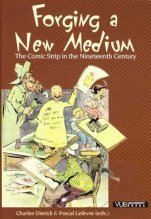
The accepted wisdom about comix is that it is a quintessential twentieth century medium, with its origin in the late nineteenth century with the publication of The Yellow Kid, but with most of its development happening from the 1920ties onwards. There's also a revisionist history that pushes the boundaries of comix history much further back, dragging everything from Egyptian hieroglyphics to Aztec drawings into the medium. The truth lies somewhere in the middle, with the second view being closer to the truth than the first in my opinion. Comics have had a long and wonderful history, maybe not quite dating back to Ancient Egypt, but existing long before the Yellow Kid was a glimmer in Outcault's eye.
Comics haven't had much love as a medium, certainly not in English speaking countries. What critical attention has been paid to it has focused more on contemporary comics than on its history. A noted exception is David Kunzle's two volume history on early comics, but those are long out of print. Forging a New Medium, a critical look at the nineteenth century comic strip, is therefore welcome as an attempt to fill the gap in the study of comics. Especially since it is an explicitly international oriented book.
Forging a New Medium grew from an international congres, Inventors of the comic strip held in Brussels in 1996, during the celebration of the centennial of the comic, as measured from The Yellow Kid, with the presentations given during this congress turned into essays for the book. If you're interested in the history of comics, the contributors should for the most part be known to you. They include David Kunzle, Paul Gravett and Thierry Groensteen, all people who've been working this subject for some time, together for the first time.
What makes this book worthwhile is not so much the depth with which it treats the subject --you cannot expect too much from a collection of essays which started out as congress presentations-- as its breath. You may be well acquainted with the history of the comic strip in England or the United States in the 19th century, but how much do you know about that and the history of the Spanish, Belgian, Dutch or Swiss comics? Each essay in here looks at a different subject, all tied together by the editors' introduction and timeline.
- In "From Mannekensblad' to Comic Strip" Patricia Vansummeren looks at the development of Belgian comic strips in the childrens magazines as they started to be published in the nineteenth century. These "mannekensbladen were still around late enough to influence classic comic artists like Herge.
- Nop Maas traces the origins of the Dutch comic strip in "The Archeology of the Duitch Comic Strip". Though the development of the Dutch comic was late in comparison to countries like the UK or France, only really starting in the 1930s, it turns out there were actual comic albums published around the turn of the century, political satire even, if rightwing political satire. In fact, Willem Bilderdijk was doing something quite like comics in 1809!
- For England, Paul Gravett traces the origins of comics back to the Golden Age of English Caraciture, 1770 to 1820 in "The Cartoonist's Progress: the Inventors of Comics in Great Britain". Also notable is Ally Sloper, not just a serious candidate for the first modern comic strip, but also one of the first comics we know which was largely the work of a fmeale cartoonist, Mary Duval.
- The most widely accepted candidate for the title inventor of comics, Rudolphe Töffer, is tackled by Thierry Groensteen in "Töffer, the Originator of the Modern Comic Strip". Töffer in his view (re)invented the comic strip around 1830, a view also advocated by David Kunzle in his earlier book on 19th century comics. Töffer was the first to realise that comics were a separate medium, and strove to gain acceptance for his works as original works of arts rather than a combination of already existing media.
- After Töffer, Wilhelm Busch was probably the most influential 19th century comics artist. His work is discussed by Hans Ries: "comic Strips in the Work of Wilhelm Busch". He was incredibly popular not just in Germany, but al around the world, with his Max und Moritz strips later transformed into the early American comic strip The Katzenjammer Kids.
- Antonio Martin describes the situation in Spain, in "notes on the Birth of Ciomics in Spain, 1873-1900". Spain was a backwards country compared to the rest of western Europe and America, which had a direct influence on its comics, which were much less developed than contemporary strips elsewhere.
- David Kunzle finally, describes the long road American comics took in the 19th century towards the "birth" of the newspaper comic strip in the last essay in the book: "Precursors in American Weeklies to the American Newspaper Comic Strip: A Long Gestation and a Transoceanic Crossbreeding. This essay shatters two myths of American comics: that it originated in the newspapers of the 1890ties and that it was a wholly domestic invention. Kunzle makes it clear there were already sophisticated comic strips being published in the comic American weeklies, often inspired by European artists, where these were not published directly.
Forging a New Medium is quite a good introduction to the rich wonders of the 19th century comic, even if it does not probe very deep into its history. Even for people who, like me, are interested in comics and the history of comics and know the broad outlines of it, there is much new to be found.
